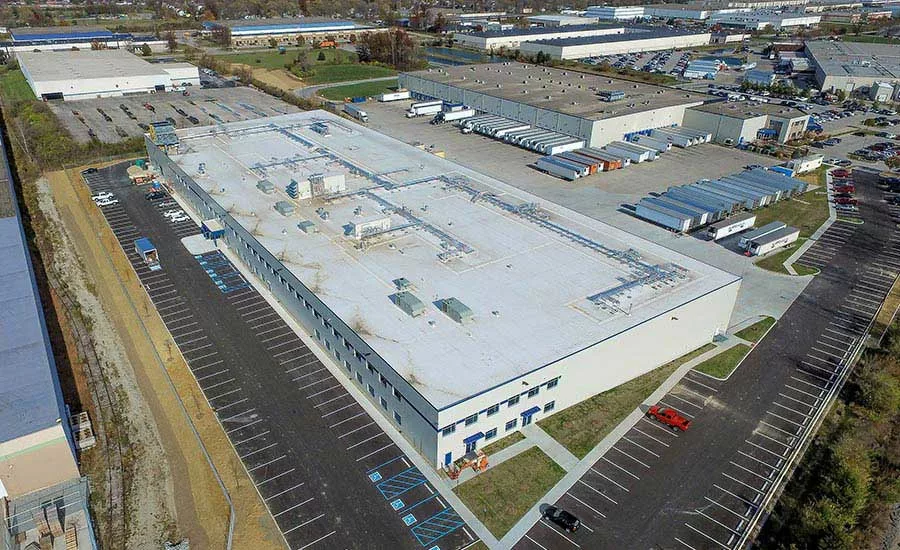Manufacturing News
FSMA demands can exceed plant capabilities
Older facilities may not be able to meet detailed requirements under FSMA

The Caito Foods Fresh Kitchen facility, designed and built by ESI Group USA, features the latest technologies in construction to meet FSMA regulations. Source: Aerial Imaging Resources.
In FE’s interviews with architectural and engineering firms for the Annual Plant Construction Survey, several A&E professionals expressed concern about the readiness of food and beverage plants for FSMA.
While large processors had to be in compliance last year, small and medium-size processors with older facilities often find that there is major work to do to get their plants in shape in terms of allergen separation and bacterial contamination, airflows and interior surface cleanability—to name a few.
But, can older facilities be upgraded to meet the new regulations?
“FSMA has really leveled the playing field for food plants,” says Mark Redmond, Food Plant Engineering, LLC president. “It’s raised the bar for all segments of the industry and increased the sanitary conditions of all food plants. FSMA has also raised the bar for food allergen control.”
Though FSMA can be accommodated in new plant design, it can be problematic for older facilities. As Keith Perkey, Haskell vice president – food and beverage, explains, FSMA has forced food and beverage manufacturing facilities to look at their hygienic design, material handling and traceability issues throughout the entire process, including their raw ingredients receiving to production and packaging through distribution.
In the design and construction of new facilities, unique plant layouts are available to ensure no cross-contamination of equipment and materials will occur. The other significant area of innovation is eliminating the opportunity for microbial growth through HVAC system design and CIP/SIP system design.
As far as upgrading old plants, generally that is a case-by-case basis; the answer depends on a risk analysis for the product.
“We are seeing some trending towards ‘greenfield’ facilities to replace old plants that are out of compliance and inefficient,” adds Perkey.
Smaller processors have been active in seeking not only upgrades to meet FSMA requirements, but also compliance with GFSI-certified schemes like BRC or SQF, says Mark Di Gino, E.A. Bonelli + Associates marketing manager.
“Larger processors have been discovering that, in many cases, it’s not worth upgrading existing facilities,” he says. “For some of our clients, they’re finding it’s harder to mediate existing conditions, and more cost-effective in the long run, to explore new facilities.”
Trying to upgrade old plants or facilities, some that weren’t designed up front for food processing, can present many challenges.
“Those familiar with food plant construction understand the need for cleanable long-lasting surfaces, sloped-to-drain floors, no ledges, coved floor-wall interfaces, etc., which are very costly to fix in existing facilities that weren’t built that way originally,” says Dean Weber, Amec Foster Wheeler project director. “Yet, we continually see a push by owners to keep costs down by expanding/squeezing process and packaging operations into existing warehouse spaces in an effort to not increase overall square footage of facilities.”
Retrofitting spaces with cleaner materials of construction for ease of cleaning is the most common upgrade, says Lloyd Snyder, PE, Woodard & Curran senior vice president. Also, zoning of the food plant can be developed when major renovations are taking place.
“We have seen owners take the ideas that have been adopted in major expansions and greenfield plants such as Bel Brands’ new plant in Brookings, SD and retrofit existing operations such as in Leitchfield, KY,” says Jonathan Marshall, Faithful+Gould senior vice president.
The use of vestibules between non-manufacturing and food manufacturing spaces continues to increase and enables a controlled environment for employee food safety hygiene functions. Enclosing utility equipment in spaces located above the food manufacturing areas removes equipment from exposure to harsh sanitation practices and eliminates the need for HVAC equipment on the roof, which minimizes employee exposure outside and reduces roof penetration risks.
“It’s all about control and containment,” says Mike Golden, Food Tech VP.
“Processors need to be able to control the flow of people, ingredients, raw product, finished product, packaging materials, trash, particulates, air, waste, water, etc. …. Upgrading older plants can be a challenge, but nine times out of ten, they are logistically in the right place [and] have a good workforce, and that alone makes them worth upgrading.”
Looking for a reprint of this article?
From high-res PDFs to custom plaques, order your copy today!





